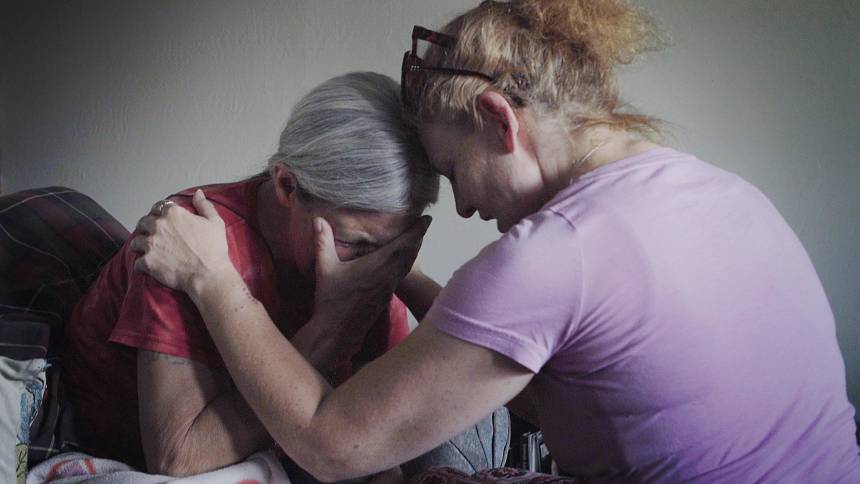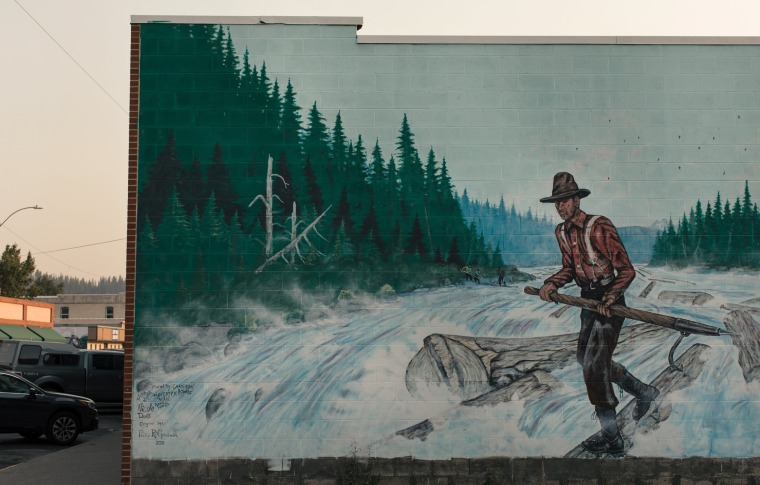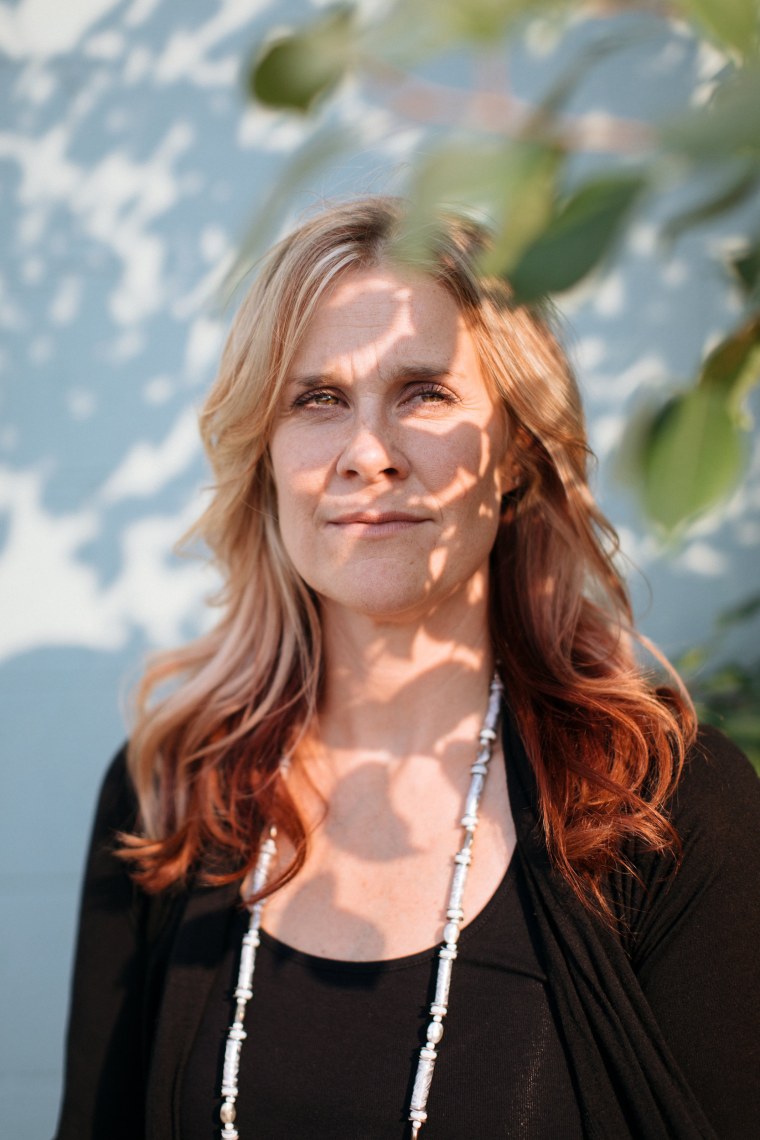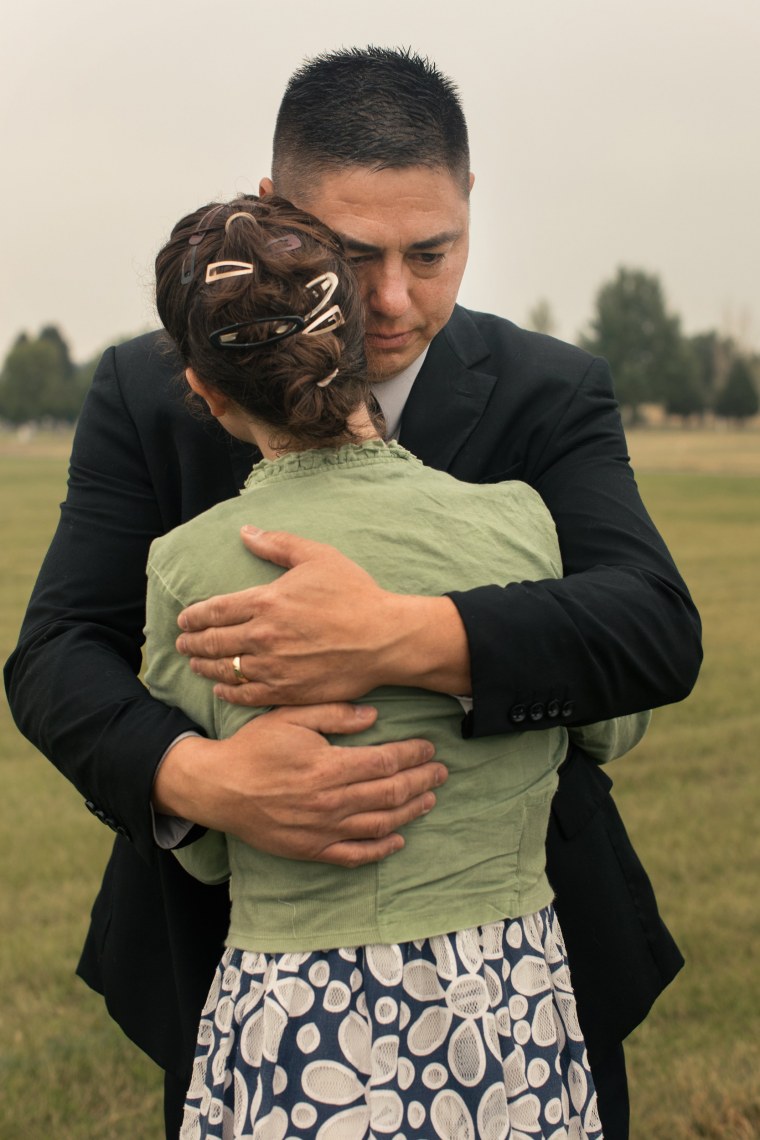Further evidence of cluelessness and indifference in too many of our state governments.
via NBCNews.com
Suicide has been a persistent problem in Montana — and it’s getting worse. Now, some who have lost loved ones are mobilizing to stop the deaths.

WOLF POINT, Mont. — Mourners in this small town in northeast Montana, where a strip of appliance shops and bars are dwarfed by vast ranches, packed into a church this month to pray for Michael Lee.
A week earlier, Michael, a 13-year-old who dreamed of playing for the NFL, had killed himself in his family’s red clapboard home. At the funeral on Aug. 3, a row of Michael’s middle-school football teammates sat behind his relatives and friends, wearing maroon jerseys and white armbands with “R.I.P.” handwritten on them. A handful of strangers were there, too; the funeral announcement said anyone affected by suicide was welcome.
That seems to include just about everybody in the state these days.
The church was silent as Colleen Timmins-Lee, Michael’s stepmother and a state trooper, rose to speak, trembling.

“If you or someone you know that you even think might be going through this, then please, please get them the help they need,” she said through tears. “Please, please just reach out and just tell one person and try to prevent another tragedy like this.”
For those who sat in the pews wiping their eyes, or who stood by the entrance of the church, where a table was covered in pamphlets on suicide prevention, the message was both urgent and familiar. Montana has the highest suicide rate of any state in the country, and while people here don’t often speak openly about sadness or loneliness, many have firsthand experience with loss.
That already included Michael’s family. Just over two years ago, his mother, Kimberley Evans, also died of suicide.
Afterward, Michael struggled. He saw counselors at a children’s mental health clinic in rural Wolf Point, but after it burned down last year, the closest available counselor was 50 miles away. Michael’s stepmother and his father, Frederick Lee, a patrol officer with the Montana Department of Transportation, couldn’t afford time off to take him there, and they said the counselors Michael had seen told them that he had improved.
Now, weeks after their son’s funeral, they were left wondering what else they could have done — and what Montana can do — to stop this from happening.
“When it comes to depression and suicide in our community,” Lee said, “it’s out of control.”
A GROWING CRISIS
Suicide has been a persistent problem in Montana — and it’s getting worse. The state saw 25.9 suicides for every 100,000 residents in 2016, nearly double the national average, according to Centers for Disease Control and Prevention data that is age-adjusted. Since 1999, that rate has risen 38 percent, even faster than the 30 percent national rise in suicides.
The challenges Montana faces are many. It’s sparsely populated — the fourth-largest state by area, it’s 44th in population, with just over a million people — and it has less than a quarter of the mental-health care providers required to serve its residents, according to the Health Resources and Services Administration. A strong gun culture and high rate of heavy alcohol consumption fuel the problem, as does lack of daylight in the winter and high altitude, which have both been linked to depression. And then there’s the stigma associated with reaching out for help, which many Montanans see as a sign of weakness.
“We have a perfect storm when it comes to suicide,” said Karl Rosston, suicide prevention coordinator for Montana’s Department of Public Health and Human Services. “We have a lot of factors that are all happening at the same time.”

Then, last year, came another blow: Facing a projected $227 million budget shortfall, Montana’s Republican-led legislature and Democratic governor made cuts to the state’s health department, including to mental health funding. As a result, more than 100 mental health professionals were laid off across the state and 10 rural health care programs were forced to close because they couldn’t afford to pay their employees, according to the Behavioral Health Alliance of Montana, an advocacy group for the state’s mental health providers.
Now, some who have lost loved ones to suicide — frustrated by the budget cuts and driven by the state’s urgent needs — are mobilizing to do whatever they can to stop the deaths. They are veterans and Native Americans, social workers and public health officials. They’re studying suicide prevention and opening clinics and speaking to students. But they still fear that, in many cases, their efforts will not be enough.
‘ONE IS TOO MANY’
When Ryan Ranalli was growing up in Helena, Montana’s capital, there was at least one suicide in his high school each year. Later, after he joined the military and served in Iraq as an Army infantry squad leader, he lost more friends to suicide. More than 200 Montana veterans killed themselves from 2013 to 2016, representing nearly a fifth of the state’s suicides in that time, according to the state Office of Vital Statistics.

“It’s one of those things, especially if you’re a male, not to ask for help,” Ranalli, 39, said. “People I served with, they don’t want to reach out and say ‘Hey, I’m having some problems, and I need to talk to somebody.’”
For Ranalli, the problems started in 2005 after several Army buddies in his unit were killed in Iraq, some by a bomb, others in a firefight. The same year, on his second deployment there, Ranalli was hit by a roadside bomb, ending his dream of a long Army career. He returned home with a traumatic brain injury, stuck in a cycle of nightmares, flashbacks, anger, depression and anxiety. The following year, two more friends died while fighting in Iraq. By 2012, Ranalli was overwhelmed by survivor’s guilt and frustration over his inability to rejoin the Army. One night, his wife found him in their garage, blackout drunk and attempting suicide.

“I felt like a burden,” he said. “I’ve seen what [suicide] does to families, but at the time, you just don’t think about it.”
Ranalli’s wife convinced him to get help, but it eventually became clear that the treatment he needed wasn’t available in Helena. There was a traveling VA clinic that came through once a month, but nothing permanent, so he underwent months of treatment out of state, in San Diego.
After his health improved and he returned home, Ranalli decided to channel his frustration with Montana’s mental health care shortfalls into action. He worked on a letter-writing campaign for a permanent veterans mental health clinic in his hometown, and this spring, the Helena Vet Center held its grand opening. So far, it’s provided over 1,055 mental health visits to nearly 150 veterans and family members. Ranalli is one of them; he receives treatment there for post-traumatic stress disorder.

In the fall, Ranalli, who has six children, plans to begin speaking about suicide prevention in local schools.
“To me, one is too many,” he said, “whether it’s a vet or a high school student.”
‘YOU LOSE A LOT’
At 19, Laurencia Starblanket, a member of the Salish Tribe, has already lost more than half a dozen close friends and relatives to suicide.
Nearly a decade ago, Starblanket’s aunt killed herself. Soon after, Starblanket’s grieving mother became addicted to pills, then heroin and methamphetamine, which has landed her in prison on and off.

Then Starblanket lost three friends, two cousins she called brothers and an uncle she considered a father figure — all died by suicide, all within the past two years.
“It’s hard. You lose a lot. A lot comes out of you,” said Starblanket, who lives in Arlee, a windswept town of about 600 on the Flathead Indian Reservation in the shadow of the Rocky Mountains. “After my [uncle] passed, I was just numb. I didn’t want to go to school. I didn’t want to do anything. I just laid in bed.”

From 2005 to 2014, the suicide rate among the indigenous population in Montana was 22 percent higher than the state’s average, according to the Department of Public Health and Human Services. And youth suicide was more than twice as common in Montana than in the country as a whole during that period.
A little over a year ago, after her cousin died, Starblanket started drinking for the first time and soon began considering suicide herself. Her family sent her to Canada to spend time with relatives, and when she returned home, she decided to go to school to study tribal governance so she could address the high suicide rate among Native Americans.

This year, after Starblanket came home, her younger sister attempted suicide. That only doubled Starblanket’s resolve. This summer, she worked as a camp counselor at a suicide prevention program at the Tribal Health Department in St. Ignatius, Montana.
“Ever since seeing my sister in a hospital bed because she wanted to kill herself,” Starblanket said, “I look at it as: I want to save someone else’s little sister.”
‘WE LITERALLY DON’T HAVE THE CAPACITY’
The mental health clinics serving Montana’s wide-flung communities were already struggling to meet the state’s growing needs. Then, over the course of 2017, the Department of Public Health and Human Services was hit with about $95 million in cuts, which resulted in the loss of at least as much money from federal matching funds, according to the Montana Budget & Policy Center, a nonprofit that analyzes budget issues and advocates for government investment in health care, education and the environment.

State officials declined to say how much of the health department cuts directly affected mental health services. But two cuts hit mental health care providers particularly hard. The state reduced the Medicaid reimbursement rate by 2.99 percent, which meant that clinics received less money when they treated low-income patients. And the state slashed Medicaid reimbursements for case managers by more than half, so that clinics receive $8.19 across the board, rather than $17.38 for children and $18.22 for adults, for every 15 minutes that case managers spend with their clients.
In response to the funding reductions, the Sunburst Community Services Foundation, a Montana nonprofit that offers mental health care as well as arts and education programs, cut anything that could be considered extra, from office supplies to training. Yet the organization is still losing about $60,000 a month and may close two of its six locations.
“They’re my people and I really care about them, but it’s like a fool’s errand,” Megan Bailey, a licensed clinical social worker who leads Sunburst’s program development, said of their clients. “We literally don’t have the capacity to hold this up any longer.”
Gov. Steve Bullock has said mental health is a priority for his administration. His office has released figures showing that mental health funding in the state has increased by millions of dollars since 2011, two years before he took office, even with the recent cuts. Still, Montana’s mental health budget lagged behind states with a comparable population from 2009 to 2015, according to data compiled by the National Alliance on Mental Illness.

Following a public backlash, including a lawsuit by the Montana Health Care Association, Bullock announced plans in July to restore funding for Medicaid reimbursements and partially restore Medicaid case manager funds. Those plans, including details on restoration amounts, will be made public by Sept. 1, the governor’s office said.
“Governor Bullock remains committed to fighting for Montanans and the essential services they deserve,” the governor’s office said in a statement. “He will again propose a budget that invests in mental health and ensures vulnerable Montanans have the health care they need. He will continue to engage in statewide partnerships to implement evidence-based programs aimed at reducing suicide in Montana.”
But struggling mental health care providers say that it may be too little, too late, and it would take years to reopen shuttered clinics and regain the community’s trust. In the meantime, Montana’s suicide toll continues to rise.
‘WE CAN’T WAIT FOR FUNDING’
Libby, Montana, is tucked between the Kaniksu and Kootenai National Forests, surrounded by mountain ranges crisscrossed with trails roamed by moose and bears. Reader’s Digest named it the state’s most charming small town this year.

But beneath the natural beauty is a growing frustration.
Libby is in Lincoln County, which has a population of nearly 20,000 but just one behavioral health employee, Amy Fantozzi, a graduate student who oversees the county’s contracts with medical providers who do mental health assessments.
The town had a clinic run by the nonprofit Western Montana Mental Health Center, the largest service provider in the region, which had 12 clinics serving 15,000 clients across 15 counties. But after the cuts were announced last year, the center laid off more than 60 case managers and shut down three clinics, including the one in Libby. That left hundreds of patients without access to therapy, medication and a case manager to check on them.

Now, when those patients are in crisis, their only option is the emergency room at Lincoln County’s lone hospital. Once they check in, Fantozzi gets a call, and she must decide whether to spend $100 of her $18,500 annual budget on a mental health assessment. Depending on the results, she could then spend an additional $300 to have the patient evaluated and involuntarily committed at the nearest mental institution 90 miles away.
There have yet to be any publicly reported deaths by suicide as a result of the local clinic’s closure, but county officials fear the current system of mental health triage won’t hold up.

“Right now it just feels like a Band-Aid on every patient,” said Jennifer McCully, 32, Lincoln County’s public health manager. “Is it going to work this time? Maybe, but we probably will see them again.”
On a recent Thursday morning, more than a dozen Lincoln County health officials, law enforcement officers, teachers, community leaders and medical providers gathered around a horseshoe of folding tables at Libby’s high school to discuss how to fill the gap left by the budget cuts. One idea was to create a list of people who may be at risk of suicide and deploy volunteers to check on them regularly.
“We can’t wait for funding,” said Liz Erickson, who provides faith-based counseling through the Libby Christian Church. “We cannot wait for the grant. We cannot wait for that help. We just have to start the dang thing ourselves.”
‘WE CAN’T GO BACK’
In Wolf Point, Michael Lee’s father and stepmother are grieving for their son, who would have started high school this fall. They are also urging everyone they know to reach out to those who may need help.
But they are well aware of Montana’s many challenges when it comes to suicide prevention, which Frederick Lee said made the recent mental health funding cuts all the more infuriating. “They’re cutting back things we need,” he said.

Lee hopes to help in any small way he can. He will soon begin a three-year course in a suicide prevention method known as QPR — which teaches participants to question, persuade and refer those thinking of suicide — so that he can train others in northeast Montana. And he plans to leave his job with the Department of Transportation to find work as a deputy in a school. He wants to talk to kids throughout the day and check in on them.
“If we had one more minute to talk to Michael about his depression, if we had one more minute to tell him that we loved him, maybe the depression wouldn’t have taken him,” Lee said, his voice breaking. “But we can’t go back. The problem is we have to go forward.”
If you or someone you know is in crisis, call the National Suicide Prevention Lifeline at 800-273-8255, text TALK to 741741 or visit SpeakingOfSuicide.com/resources for additional resources. Montana residents can find a list of local resources here.
Phil McCausland reported from Helena, Libby and St. Ignacius, Montana; Elizabeth Chuck reported from New York; Annie Flanagan reported from Wolf Point, Montana; and Mariana Keller reported from Missoula, Montana.
